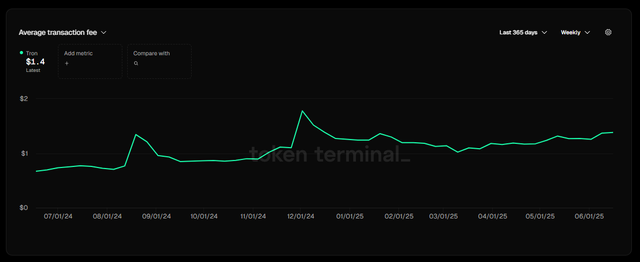USDT Fees Become 106% More Expensive on Tron
The cost of transactions on the TRX network has doubled, especially for USDT, jeopardizing its appeal for small transfers and mass adoption.
The Tron (TRX) blockchain, known for its low fees and being the main network for more than 50% of USDT tokens in circulation, is experiencing a dramatic increase in its transaction fees. According to data from Token Terminal, the average fee for transferring TRC-20 tokens skyrocketed 106.06% in just one year, rising from $0.6697 on June 17, 2024, to $1.38 on June 17, 2025. This increase, driven by the movement of stablecoins like USDT through smart contracts, could alienate retail users who rely on the network for small transactions, such as remittances.

The average fee for transferring TRC-20 tokens skyrocketed 106.06% in just one year / Token Terminal
The Unexpected Rise: Tron Faces Escalating Costs
Tron's narrative has always revolved around efficiency and low fees, positioning itself as an attractive alternative for fast and cheap transfers. However, on-chain data from Token Terminal reveals a worrying shift. The amount of transaction fees using TRX as a payment token is clearly on an upward trend.
Just a year ago, on June 17, 2024, the average cost to transfer tokens on Tron's TRC-20 network was $0.6697. Today, June 17, 2025, that figure has risen to $1.38. This 106.06% increase in just twelve months is a factor that users and developers cannot ignore.
USDT on Tron: The Reason Behind the Surge
Tron has established itself as a giant in the stablecoin ecosystem, holding just over 50% of all USDT tokens in circulation due to its low fees. This massive adoption of USDT on the Tron network is, paradoxically, one of the main reasons behind the rise in fees.
Unlike transfers of the native token TRX, which are simpler and more straightforward, moving USDT on the Tron network involves interacting with a smart contract. For a stablecoin like USDT to function on a blockchain, it is issued and managed through a smart contract (in this case, a TRC-20 contract). Every time a user sends USDT, they are not only moving the token, but also executing a function within that smart contract. Smart contract transactions are inherently more complex and therefore consume more network resources (gas), which translates into higher fees.
In practice, the Tron network charges different gas fees depending on the type of transaction, for native TRX and others for USDT, for example. For example, according to on-chain data, sending the native TRX token can cost as little as $0.30. However, performing a transaction with a non-native token like USDT (a TRC-20 token) can reach an average of $369. This disparity is a direct reflection of the increased complexity and resource consumption associated with executing smart contracts for tokens like USDT.
Impact on Retail Users and Remittances
The significant increase in fees, especially for USDT transfers, could have a direct impact on Tron's user base. The network has been a popular choice for retail users and remittance transfers due to its historically low costs.
However, if sending a small amount of money costs $3.69 in fees, this represents a very high and unprofitable percentage for low-value transactions. Users who rely on these competitive fees for remittances or small, everyday transactions could begin to look for alternatives on other blockchains or cheaper transfer methods, eroding Tron's advantage in this market segment.
Challenge for Retail Users
The meteoric rise in fees on the Tron network, which has climbed over 106% in one year and reached an average of $1.38 per transaction, is a warning sign. While the popularity of USDT on its network is a driver of growth, rising smart contract costs are testing Tron's value proposition for retail users. The network now faces the challenge of balancing its growth and demand for stablecoins with the need to maintain competitive fees, which are critical to its appeal in a constantly evolving market. Tron's ability to address this issue will determine whether it can retain its position as one of the most used networks for everyday transactions and remittances.
Disclaimer: This article is for informational and journalistic purposes only and does not constitute financial advice or investment recommendations. Cryptocurrencies and their fees are subject to market volatility. Users are advised to conduct their own thorough research and consult a professional before making any decisions or engaging in transactions.
Upvoted! Thank you for supporting witness @jswit.